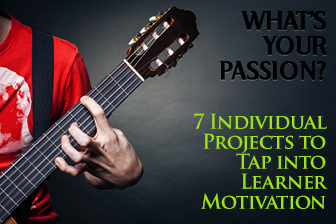Getting Them Excited: 6 Methods to Ignite Enthusiasm in Your Students


In some cases, they are largely correct: school has become a place more about satisfying bureaucratic than student need: endless tests and boxes to check. But does it have to be this way? Absolutely not. There are numerous methods to connect the classroom to the outside world and in the process awaken passion for the learning process in students.

By tradition and in most cases by necessity, curriculum is top-down: generated by administrators who pass it down to teachers, who also might tinker with it but have less control that administrators, and finally down to students, who have least control of all, despite being most affected by the curriculum. Although teachers and students have little control over this process, they may, within the confines of the class, reorder it somewhat, designing the curriculum process to originate with students and their needs and interests. This may be done through a short period of assessing students to find their level as well as learning about their needs and interests.
One place to start in reordering the curriculum is finding out student passions and let that drive the curriculum. Through class discussions, interviews, and writings, find out what students are truly interested in: twentieth century art? Classic cars? Karate? The topics are bound to be diverse, of course, but there’s also likely to be a lot of overlap—more than one student will be interested in art or cars, for example. It is around these topics then a curriculum of discussion, reading, research, and writing can be built.
Often students are discouraged and have been sent messages, either overtly or covertly, that their interests as irrelevant, so they refuse to discuss them. Therefore, the teacher must spend some time getting to know her students, and letting the students get to know each other, to learn what students are passionate about. Taking students seriously and asking questions is important: “So you’re interested in hip-hop! What about it excites you?” After I spent some initial time with a student talking about this particular passion and assuring him that it was legitimate and appropriate for school, he went on to form a team of like-minded students who did some research on the hip-hop field—there is a body of literature and experts—and did a presentation including some hip-hop music.
Often students have a particular interest, such as women in the military, but beyond Googling the term, don’t know where to go with it. The only “research” they may know about is the internet or the library. Pointing out other avenues of legitimate and helpful research, such as interviewing a family member or friend in the military, will give students some direction. In addition, students often think they won’t be taken seriously in their efforts to find out more about their interests. One young man, hesitant to contact a leading hip-hop figure, said to me “I totally don’t expect him to get back to me.” When I reassured him on this, pointing out that people passionate about a topic are usually eager to talk about it to others also passionate, he went ahead and contacted the hip-hop leader—and was “totally” surprised when the gentleman returned his email and gave him some important leads. So guide students to avenues they might take to explore their passions.
Once student interest has been ignited, it will further catch by making connections to the “real world” outside of school. Students often are alienated from school for just that reason—it seems separate from and unimportant to their “real” lives outside. If teachers can make that connection to the “real world” by demonstrating, for example, that what a student read on pet care in class has direct application to working as a veterinarian assistant, then they can begin to see the value of school.
Along the way of sharing ideas from their readings and discussing and writing together, students will look around and realize that they’ve become a community—a learning community. The teacher is a part of this community and in some ways equal to the students because she is another learner in this community, not possessing all of the knowledge of the different areas of study that the students have, in addition to still being a teacher—as all the students are as well of their areas of interest.
When the learning community has formed, and students have spent some time reading, writing, and discussing their topics, students are ready to work together on projects. Again, as much students control over the process should be allowed: students should form groups based on their interest and decide what their project will be: if their interest is cars, for example, their project may be a design for a car and presentation about it. They should also assign roles within their groups: team leader, researcher, reporter, resource manager, and so forth. This is the culmination of the term’s study and usually gives students a deep sense of control and value for the material in that they are able to produce something that would be valued in the “real world.”
However, through some methods such as student-generated topics and projects, instructors can help make those connections to the “real world” while igniting a passion for learning.
What are your students’ passions? How might you use them in the learning process?